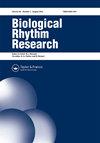Study on the related factors affecting the circadian rhythm of blood pressure in patients with essential hypertension
IF 0.9
4区 生物学
Q3 BIOLOGY
引用次数: 1
Abstract
ABSTRACT This study explored the related factors affecting the circadian rhythm of blood pressure in patients with essential hypertension. According to blood pressure rhythm, 1007 patients with essential hypertension were divided into dipper (n = 332) and non-dipper group (n = 675). Age, gender, height and other basic information were collected, BMI was calculated, and FPG, TG, TC and other indicators were recorded. Meanwhile, carotid ultrasound, office BP, central hemodynamic parameters, and other indicators were recorded. Logistic regression was used. In comparison, dSBP, dDBP, nSBP, nDBP, nocturnal systolic blood pressure and nocturnal diastolic blood pressure drop rate, 24 hSSD, 24 hDSD and dSSD were statistically significant (P < 0.05). The results showed no distinct differences in CSP, CDP, CPP, AP, Aix and AIx75 in CAP between two groups (P > 0.05). Log regression analysis showed that for every increase in nocturnal SBP, dipper hypertension was more likely to occur than non-dipper hypertension. Circadian rhythm of blood pressure of hypertension in patients with essential hypertension is mainly the influence of circadian blood pressure and nocturnal blood pressure drop rate, especially for the nocturnal systolic blood pressure, so effective control of blood pressure at night could make the circadian rhythm of blood pressure tend to be in dipper type distribution.影响原发性高血压患者血压昼夜节律的相关因素研究
摘要:本研究探讨影响原发性高血压患者血压昼夜节律的相关因素。1007例原发性高血压患者根据血压节律分为滴斗组(n = 332)和不滴斗组(n = 675)。收集年龄、性别、身高等基本信息,计算BMI,记录FPG、TG、TC等指标。同时记录颈动脉超声、办公室血压、中心血流动力学参数等指标。采用Logistic回归分析。相比之下,dSBP、dDBP、nSBP、nDBP、夜间收缩压和夜间舒张压下降率、24 hSSD、24 hDSD和dSSD均有统计学意义(P < 0.05)。结果显示,两组间CAP的CSP、CDP、CPP、AP、Aix和AIx75均无显著差异(P < 0.05)。对数回归分析显示,每增加一次夜间收缩压,北侧高血压比非北侧高血压更容易发生。原发性高血压患者的血压昼夜节律主要受昼夜血压和夜间血压下降率的影响,尤其是对夜间收缩压的影响,因此有效控制夜间血压可使血压昼夜节律趋向于扁斗型分布。
本文章由计算机程序翻译,如有差异,请以英文原文为准。
求助全文
约1分钟内获得全文
求助全文
来源期刊

Biological Rhythm Research
生物-生理学
CiteScore
3.00
自引率
9.10%
发文量
34
审稿时长
6-12 weeks
期刊介绍:
The principal aim of Biological Rhythm Research is to cover any aspect of research into the broad topic of biological rhythms. The area covered can range from studies at the genetic or molecular level to those of behavioural or clinical topics. It can also include ultradian, circadian, infradian or annual rhythms. In this way, the Editorial Board tries to stimulate interdisciplinary rhythm research. Such an aim reflects not only the similarity of the methods used in different fields of chronobiology, but also the fact that many influences that exert controlling or masking effects are common. Amongst the controlling factors, attention is paid to the effects of climate change on living organisms. So, papers dealing with biometeorological aspects can also be submitted.
The Journal publishes original scientific research papers, review papers, short notes on research in progress, book reviews and summaries of activities, symposia and congresses of national and international organizations dealing with rhythmic phenomena.
 求助内容:
求助内容: 应助结果提醒方式:
应助结果提醒方式:


